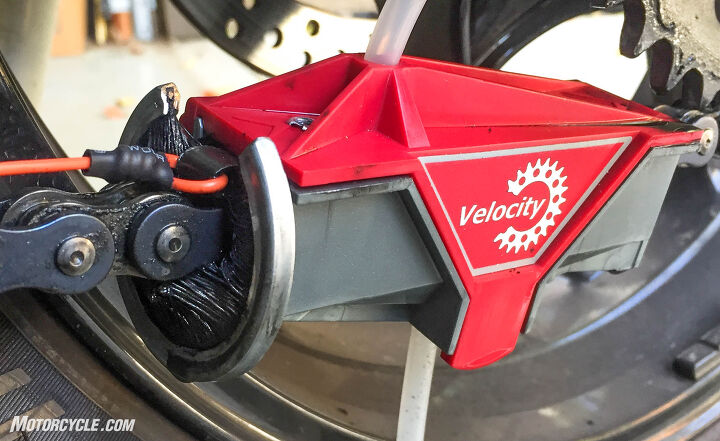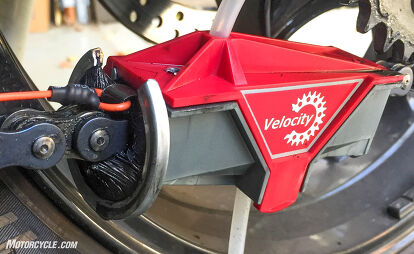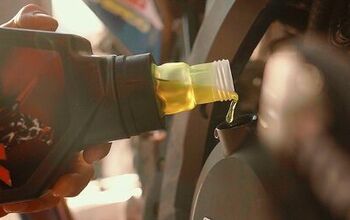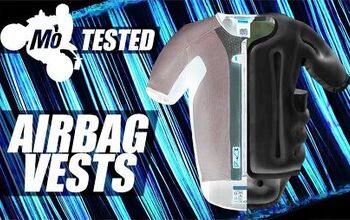MO Tested: Velocity Chain Maintenance System

Making a messy chore much easier - and cleaner
In the past, I’ve called cleaning your motorcycle’s chain a messy-but-necessary task. Lubing the chain can also be messy if you’re careless, but neither chore needs to be that way. The secret is performing both frequently. After some time sampling the Velocity Chain Maintenance System, I think it could be just the ticket for simplifying both activities – and making a little less mess in the process.
First, we need to establish that the Velocity Chain Maintenance System will work best on a chain that is not completely encrusted with dirt. As the Velocity website explains: “The system is designed to ‘contain and control’ and is not a ‘power-washer’… It is designed for routine maintenance application to prevent the build-up of road-grit and the cleaning process is accelerated by regular use under conditions of moderate accumulation.” Even E-i-C Duke questioned me about what kind of chain-cleaning product would recommend starting with a relatively clean chain.
However, after spending some time thinking about the issue, this distinction makes sense to me. The degree of effort required to clean a filthy, mung-covered chain is quite different from a regular, maintenance cleaning. The folks behind Velocity have clearly considered this issue because a $12 Velocity Chain Brush is available for extra scrubbing power when needed. So, if you’ve neglected your chain for an extended period, you would be better served by following the steps in this chain cleaning article before beginning a routine maintenance schedule with the Velocity system.
A second caveat bears mentioning: The internal width of the Velocity Chain Maintenance System fits 525 or 530 chain with a maximum width of 22.25mm (approximately 7/8 in.). Since the Velocity website recommends that owners of 800cc bikes and over measure their chain, I felt pretty safe ordering this tool for my 2003 Yamaha R6. Well, the DID chain I have on it measures in at just over 24mm in width from pin-tip-to-pin-tip. Simply put, it doesn’t fit. So, don’t assume anything; measure first. When I contacted the “Chief Sprocket” at ChainLuberSystems, LLC (the Velocity’s manufacturer), I was informed a new patent for a model that will accommodate chains up to 1.5 inches wide has been applied for, and the product should be introduced next year. A quick side note: The new luber will also work for applying belt dressing to belts up to 1.5 in., too.
Lucky for me I had a KTM 690 Duke in my garage that had a chain in need of cleaning, so I was still able to put the Velocity Chain Maintenance System through its paces – though the dark coloring of the chain makes the cleaning harder to see in the photos. Installing the Velocity system is fairly straightforward: open the unit, slip it over the chain, and snap its magnetically-assisted latch closed. Slide the unit back on the chain until it is about one inch from contacting the rear sprocket. Find a solid place on the frame or footpeg to secure the unit with the attached wire and give the wheel a test spin to make sure that everything is secure. Now, you’re ready for the fun part. Time spent so far: less than one minute.
The Velocity system comes with three tubes to affix to the unit. The first is the drain tube which can be fed into a bottle or, as I did, into a dish that could also catch any drips exiting the rear of the assembly. For the solvent/lube input hole, you have a choice between one tube that allows the use of the kit’s syringe and another specifically for spray cans. The syringe is good for using kerosene as a solvent or gear oil – the-heavier-the-better – both of which can be purchased cheaply in volumes that would potentially allow years of use. These two options were instrumental in my choice to try the Velocity Chain Maintenance System. I’ve always used spray-on chain lube because of its resistance to flinging off at speed, so I wanted to maintain that routine. Still, I know plenty of riders who will love this kit because they can use cheap, plentiful gear oil.
Using a spray chain cleaner with the Velocity system was the least messy of any chain cleaning I’ve ever attempted. No overspray needed to be wiped off the tire or other motorcycle parts. A couple drops ended up on my Absorb-It Mat, but a quick adjustment of the catch pan’s position prevented any further spilling. If you’re wondering why the recommended placement for the Velocity is as close as possible to the rear sprocket, the answer is that, as the chain curves around the sprocket, the excess cleaner and lube tends to drip off at the lowest point, providing a specific place for the catch pan.
While it is unrealistic to expect a spray-on chain-cleaning tool to get a chain as clean as meticulously brushing it inch-by-inch by hand, the Velocity Chain Maintenance System directs the spray well enough for you to see the liquified mung pour off the chain into the pan. The Velocity Chain Brush picks up a bunch more, but in order to get a truly clean chain, the brush should be rotated into a few different positions to give the bristles a chance to attack the crevices from a variety of angles. Additionally, while you could let the chain air dry after applying the cleaner, wiping it down with a rag will speed up the drying and add an extra level of cleaning.
Using a spray chain lubricant is just as easy as the cleaning. Squeeze the spray top to get the proper flow and then rotate the chain through the Velocity a couple times. You don’t need to saturate the chain because the excess will just fling off the next time you ride. In fact, just before your next ride, spray some WD–40 into a rag and use it to wipe off the excess lube from the chain. This shouldn’t take more than 15 seconds or so.
The Velocity Chain Maintenance System takes a mind-numbingly tedious chore and makes it, well, merely a chore. When I think back to all the times I’ve had to scrounge for a piece of cardboard that is just the right size to keep the cleaner from hitting the rear wheel, I know why all-too-often I just decided a quick wipe with WD–40 and a rag would suffice. My experience with the Velocity Chain Maintenance System was extremely positive – on the chains that it fits. Now, I really have no excuse for avoiding regular chain maintenance.
If your motorcycle has a chain that is too large, you’re SOL, for now. Hopefully, the larger system will hit the market early in 2017. For $30 ($42 if you add the brush), the Velocity Chain Maintenance System is a tool that many riders will be happy to have in their maintenance kit.
For more information, visit the ChainLuberSystems website.
Other chain articles:
Ten Steps To A New Chain And Sprockets

Like most of the best happenings in his life, Evans stumbled into his motojournalism career. While on his way to a planned life in academia, he applied for a job at a motorcycle magazine, thinking he’d get the opportunity to write some freelance articles. Instead, he was offered a full-time job in which he discovered he could actually get paid to ride other people’s motorcycles – and he’s never looked back. Over the 25 years he’s been in the motorcycle industry, Evans has written two books, 101 Sportbike Performance Projects and How to Modify Your Metric Cruiser, and has ridden just about every production motorcycle manufactured. Evans has a deep love of motorcycles and believes they are a force for good in the world.
More by Evans Brasfield













































Comments
Join the conversation
I run Maxima Chain Wax on my fleet. Good stuff. Long chain life and not messy at all. Try it.
For $12, this looks pretty good and I will consider it for my street bike.
On my dirt bike, which can have a truly dirty chain, I used to tediously clean it with a stiff nylon bristle brush. Nylon works best vs. metal. Now I just power wash the damn thing, blast it (and the rest of the bike) dry with an electric leaf blower, put a rag on the slider, turn it by hand and lube. Seems to work pretty good, the dirt bike is 6 years old, has almost 200 hours on it and is only on it's 2nd chain. Water is less bad for chains than dirt it seems.
As for the power washer, I use an AR Blue Clean SS390 electric. It is perfect for washing bikes - strong enough to clean it, but not overkill gas powered machine strong.